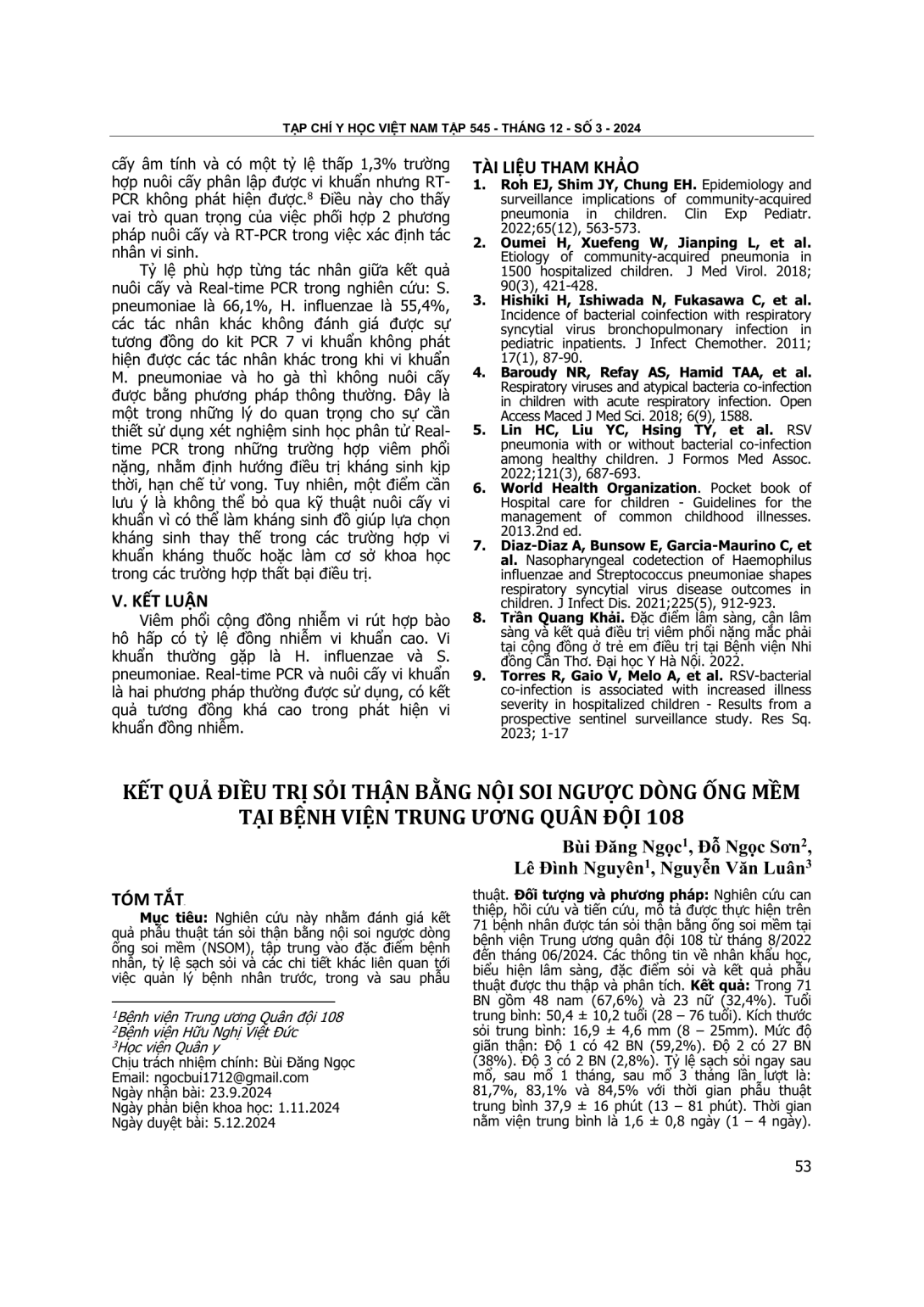
Nghiên cứu này nhằm đánh giá kết quả phẫu thuật tán sỏi thận bằng nội soi ngược dòng ống soi mềm (NSOM), tập trung vào đặc điểm bệnh nhân, tỷ lệ sạch sỏi và các chi tiết khác liên quan tới việc quản lý bệnh nhân trước, trong và sau phẫu thuật. Đối tượng và phương pháp: Nghiên cứu can thiệp, hồi cứu và tiến cứu, mô tả được thực hiện trên 71 bệnh nhân được tán sỏi thận bằng ống soi mềm tại bệnh viện Trung ương quân đội 108 từ tháng 8/2022 đến tháng 06/2024. Các thông tin về nhân khẩu học, biểu hiện lâm sàng, đặc điểm sỏi và kết quả phẫu thuật được thu thập và phân tích. Kết quả: Trong 71 BN gồm 48 nam (67,6%) và 23 nữ (32,4%). Tuổi trung bình: 50,4 ± 10,2 tuổi (28 – 76 tuổi). Kích thước sỏi trung bình: 16,9 ± 4,6 mm (8 – 25mm). Mức độ giãn thận: Độ 1 có 42 BN (59,2%). Độ 2 có 27 BN (38%). Độ 3 có 2 BN (2,8%). Tỷ lệ sạch sỏi ngay sau mổ, sau mổ 1 tháng, sau mổ 3 tháng lần lượt là: 81,7%, 83,1% và 84,5% với thời gian phẫu thuật trung bình 37,9 ± 16 phút (13 – 81 phút). Thời gian nằm viện trung bình là 1,6 ± 0,8 ngày (1 – 4 ngày). Tổng tỷ lệ tai biến biến chứng trong và sau mổ là 12,7%, ở mức độ nhẹ (Phân độ I, II theo Clavien-Dindo). Kết luận: Kết quả của nghiên cứu hiện tại cho thấy phương pháp nội soi ngược dòng ống mềm kết hợp với laser Holmium có thể được coi là lựa chọn ưu tiên để điều trị sỏi thận có kích thước ≤25 mm, do tỷ lệ thành công cao, thời gian nằm viện ngắn và tỷ lệ tai biến biến chứng ở mức chấp nhận được.
This study aimed to evaluate the outcomes of retrograde intrarenal surgery (RIRS) for the treatment of kidney stones, focusing on patient characteristics, stone-free rates, and perioperative management. Materials and Methods: This study is a combined retrospective and prospective, descriptive case series of 71 patients treated with flexible ureteroscopy for kidney stones at the Central Military Hospital 108 from August 2022 to June 2024. Patient data, including demographic information, clinical presentations, stone characteristics, and surgical outcomes, were collected and analyzed. Results: The study included 71 patients: 48 males (67.6%) and 23 females (32.4%), with a mean age of 50.4 ± 10.2 years (range 28-76). Mean stone size was 16.9 ± 4.6 mm (range 8-25 mm). Hydronephrosis was graded as Grade 1 in 42 patients (59.2%), Grade 2 in 27 (38%), and Grade 3 in 2 (2.8%). Stone-free rates immediately postoperatively, at 1 month, and at 3 months were 81.7%, 83.1%, and 84.5%, respectively. Mean operative time was 37.9 ± 16 minutes (range 13-81 minutes). Mean hospital stay was 1.6 ± 0.8 days (range 1-4 days), shorter than with other surgical methods. The overall complication rate was 12.7%, with all complications being Clavien-Dindo Grade I or II. Conclusions: The results of this study suggest that modular flexible ureteroscopy and Holmium laser lithotripsy can be considered a primary treatment option for renal and proximal ureteral calculi ≤25 mm in size, due to its high success rate, short hospital stay, and acceptable complication rate. Further studies are warranted to optimize treatment protocols and improve long-term stone-free rates.
- Đăng nhập để gửi ý kiến
